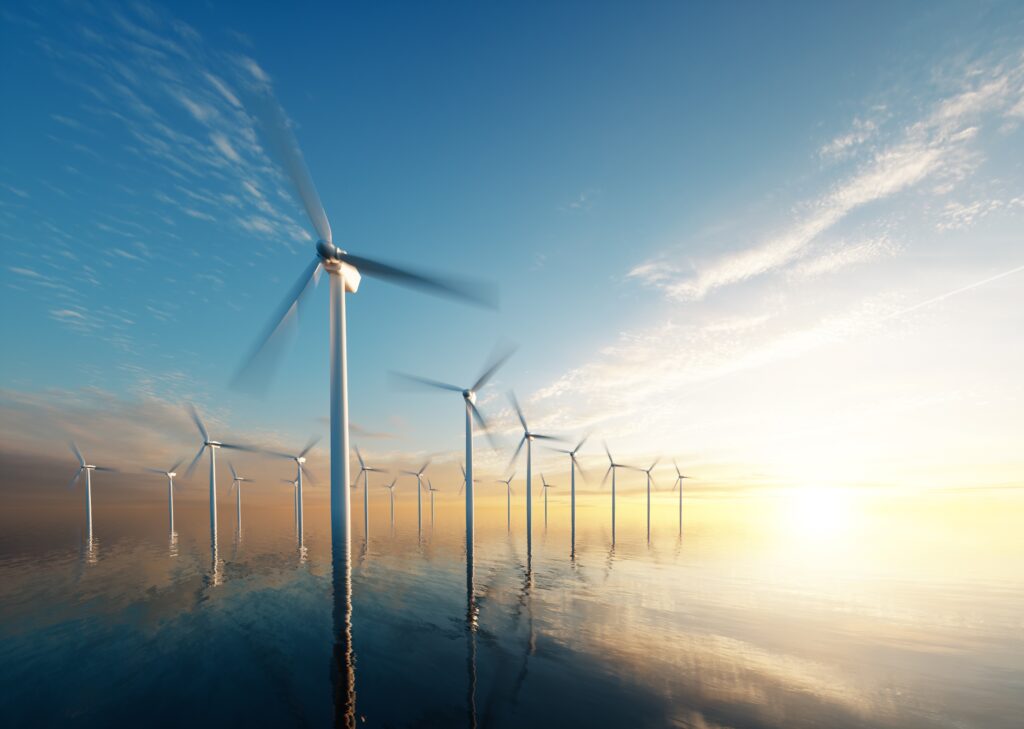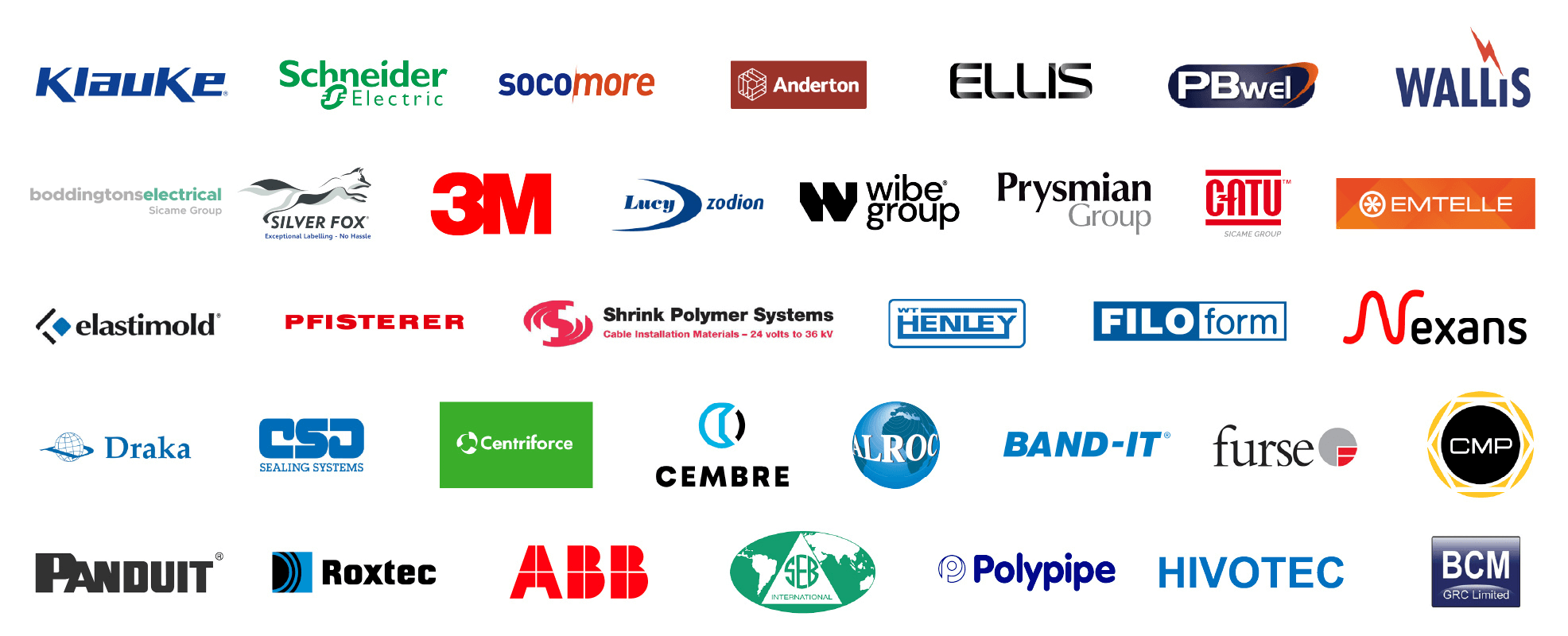Subsea Cable Protection
Lead-Free Cables | The Future for Offshore Wind Farms
September 15th, 2021Offshore Wind Farms
Prysmian Lead-Free Cables
Wind power continues to emerge as one of Germany’s key energy sources.
Offshore turbines are being engineered for ever greater capacities, which presents new challenges for energy transmission in the turbines themselves and in the offshore wind farms. As well as the technical challenges, health and safety considerations are another important factor.
Operators of offshore wind farms are increasingly designing their systems for higher voltages because of the continual rise in power demands, and also because it makes the process of transmitting the energy generated by the wind farm far more efficient. Offshore wind farms currently operate at 66kV and are preparing for an upgrade to 132kV. This places extremely high demands on the turbine installations as well as the associated cabling and connection equipment.
Installations out at sea also need to be as easy as possible to maintain and offer maximum resistance to salt water and the harsh marine climate. Moreover, health and safety aspects must be taken into account as a priority alongside the technical requirements. From a technical standpoint, offshore wind parks are governed by the standards set by the International Electrotechnical Commission (IEC). The Prysmian Group offers a large portfolio of innovative cable solutions specified to meet these requirements. Prysmian invests on an ongoing basis in the development of cable technologies that reduce lead content, aimed at creating innovative and more efficient solutions.

Prysmian Windflex Cable
For the toughest conditions: optimized cable solutions for offshore applications
Under its trademarked brands Feltoflex® and Windflex® the Prysmian Group offers cable solutions that withstand the toughest condition on the high seas and the very specialized technical specifications of the wind energy industry. The low bending radius of Prysmian Feltoflex cable saves space during routing – a feature that distinguishes it from other products currently on the market. Feltoflex cables are also well suited to connecting offshore platforms with one another, an application that demands a high degree of flexibility as the platforms can move relative to each other.
The Feltoflex solution is used primarily in those cases where the sea cable cannot be attached directly to the switchgear that connects it with the tower. This is where the Feltoflex line serves as a so-called dropper cable, securing the connection between the turbine and the network. To be more precise, it docks onto the array cable that connects the offshore wind farm’s individual turbines and enables transmission to land of the wind energy generated. The dropper cable thus forms the connection between the wind turbine and the network. One of the most notable technical benefits of the Feltoflex solution compared with conventional high-voltage cable is its tight bending radii.
This means it can be installed in extremely small spaces and, as a result, significantly reduce construction and installation costs.
Because the wind turbine’s nacelle turns as the wind direction changes, the power cables that transmit the energy down the tower have to turn with it. Windflex and Feltoflex cables come into play where the lines run in a cable loop. This is where flexibility really matters in order to prevent potential mechanical damage and breaks.
A number of factors must come together to ensure maximum flexibility of the Windflex cable – most notably the thickness of the sheathing, the construction of the energy conductor and the ductility and fire retardance of the material.
The big advantages of the Windflex and Feltoflex range include their mechanical resilience and especially their outstanding torsional performance. Among the parameters tested is whether the nacelle in the tower is able to rotate several times by up to 100 degrees per meter in one direction without damaging the cable. They are also put through their paces to ensure they are robust enough to withstand extreme fluctuations in windspeed and temperature. Windflex and Feltoflex cables can cope with temperatures from -40 to +80 °C. Environmental conditions can vary substantially and call for project-specific adaptations. Windflex cables are zero-maintenance and overwhelmingly wear-resistant.
The Windflex product range was used for the first time in 2005, and has been running in those installations ever since without a single failure. The range is engineered to last the entire lifecycle of a platform, i.e. at least 25 years. Extensive testing on facilities such as Prysmian’s own torsion test rig provide the basis for first-class product quality and contribute to an ongoing expansion of the digital database.

Prysmian Feltoflex Cable
Prysmian Group
Prysmian Group is world leader in the energy and telecom cable systems industry. With almost 140 years of experience, sales exceeding €11 billion, about 29,000 employees in over 50 countries and 106 plants, the Group is strongly positioned in high-tech markets and offers the widest possible range of products, services, technologies and know-how.
It operates in the businesses of underground and submarine cables and systems for power transmission and distribution, of special cables for applications in many different industries and of medium and low voltage cables for the construction and infrastructure sectors.
For the telecommunications industry, the Group manufactures cables and accessories for voice, video and data transmission, offering a comprehensive range of optical fibres, optical and copper cables and connectivity systems. Prysmian is a public company, listed on the Italian Stock Exchange in the FTSE MIB index.

Prysmian Joints, Cleats & Cables Terminations
Further Reading
Onshore Cable Pulling Starts At Seagreen Offshore Wind Farm
Providing Electrical Safety & PPE to Offshore Wind Farm Workers
Cable Testing – Is Resonance Testing The Way Forward For Offshore Wind?
PRYSMIAN – DISTRIBUTORS, STOCKISTS & SUPPLIERS
Thorne & Derrick provide competitive prices and fast delivery from stock for the complete range of Prysmian cable cleats, joints and glands. We distribute Prysmian cable cleats, joints, glands and connectors for terminating and jointing cables including low, medium and high voltage cables – contact us for competitive price quotations and delivery from stock for the Prysmian product range.
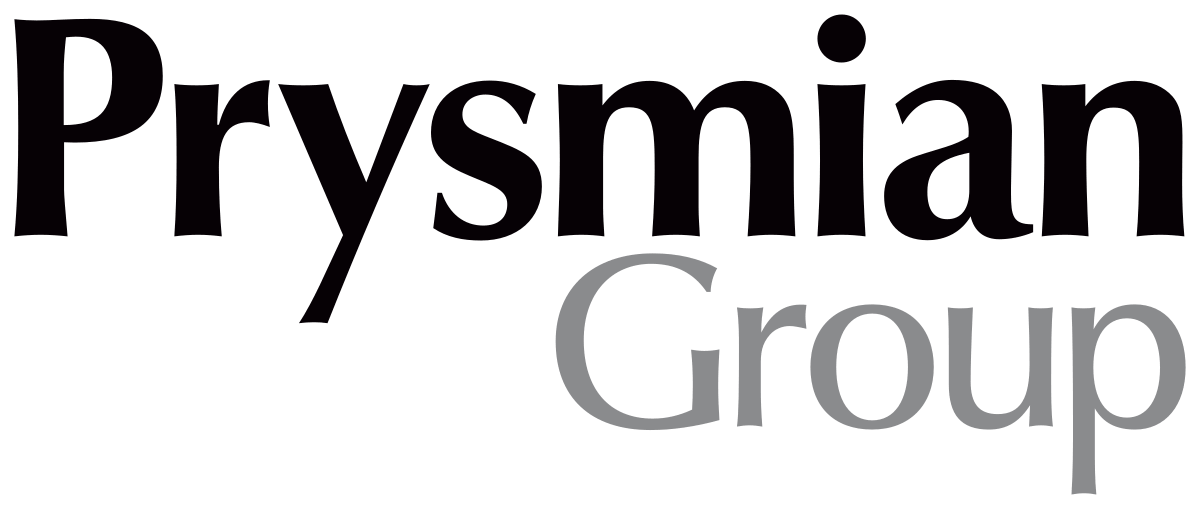
Avoiding Subsea Cable Failures Before They Hit The Water
December 7th, 2020
RenewableUK
Subsea Cable Failure
Republished from RenewableUK & Subsea UK Cables 2020 Event Special thanks to Aparna Coutinho Head of Marketing at RenewableUK Author: Alex Neumann, Head of High Voltage, Offshore Renewable Energy (ORE) Catapult
Subsea cable failures remain one of offshore wind’s biggest headaches, continuing to account for the bulk of insurance claims made by our sector.
A failure can arise from minute defects, but can spiral into big cost consequences and months of lost generation, investigation and repair work.
Induced currents and water ingress, for instance, can accelerate ageing of components within cable systems and lead to premature cable failure.
The cost of repairing a subsea cable can reach £2-5 million per km, so a fault, such as a cable short-circuit, could prove costly for developers.
Ensuring that hidden design or material flaws in cables are caught before installation is the mission of my team at our UKAS-accredited facility located in ORE Catapult’s National Renewable Energy Centre in Blyth.
If a cable fails a test in a warm, dry laboratory (albeit subjected to a variety of stresses!), it will not withstand the extreme loads and harsh conditions experienced subsea.
This role is crucial for cable designers, researchers and manufacturers who are seeking to improve their designs and bring new innovations to market.
Cable customers need to be aware that it is their role to specify appropriate test regimes above the standards’ requirements. Meanwhile, the research we conduct for owner/operators provides understanding of the root causes of failures, as well as directly furnishing the insurance community with intelligence to support claims settlement.
Cable Qualifications – Fit For Purpose?
The process for truly testing if a cable is fit to deploy has to go beyond official standards and qualifications. Compliance with these is a bare minimum, in my view.
I argue that a cable can only be considered gold-plated for offshore installation once a more rigorous set of criteria are met.
At this year’s Cables 2020, Alex will be leading a roundtable to discuss precisely this issue.
I will be ready to answer questions on the techniques we currently apply to cables in our test regimes. These include accelerated ageing of cables, thermal stability testing and a variety of forensic investigations that include such wizardry as heating insulation in silicon oil, rendering it transparent and revealing the flaws contained within.
I’ll also be keen to emphasise the benefits of knowledge-sharing in the industry: testing individual cable designs is one thing, but without greater transparency on why cables fail in the field, we will not progress as an industry. You can find out more details about our newly launched ELECTRODE programme, led by my colleague Charlotte Strang-Moran in her recent blog, as she builds the world’s first database of offshore wind cable failure data.

Alex Neumann, Head of High Voltage, Offshore Renewable Energy (ORE) Catapult
Alex led the Cables 2020 Problem Solving Roundtable on Cable Design, Test and Manufacturing (13.30-14.40, Tuesday 24th November).

RenewableUK
About RenewableUK
RenewableUK members are building our future energy system, powered by clean electricity.
We bring them together to deliver that future faster; a future which is better for industry, bill-payers, and the environment. We support over 400 member companies to ensure increasing amounts of renewable electricity are deployed across the UK and access markets to export all over the world. Our members are business leaders, technology innovators, and expert thinkers from right across industry.
Thorne & Derrick are Specialist Distributors to the UK and international Offshore Wind & Renewable industry to provide safe and reliable LV HV Electrical Cable & Power Distribution Systems up to 66kV – we are highly customer responsive and absolutely committed to providing a world-class service.
Contact our UK Power Team for competitive quotations, fast delivery from stock and technical support or training on all LV-HV products.
Key Product Categories: Duct Seals | Cable Cleats | Cable Glands | Electrical Safety | Arc Flash Protection | Cable Jointing Tools | Cable Pulling | Earthing | Feeder Pillars | Cable Joints LV | Joints & Terminations MV HV

See how T&D support, supply and service the Renewable Energy industry.

MV HV Cables 11kV 33kV 66kV | Cable Joints, Terminations & Connections
Subsea Cable Protection Systems by First Subsea | 5 Essential Articles
September 17th, 2019
Subsea Cable Protection Systems
♦ Republished by Chris Dodds with Kind Permission of Greg Campbell-Smith ((Director Sales and Business Development at First Subsea)
First Subsea are the world’s leading developer of subsea cable protection systems and connection technology; supplying, installing and decommissioning.
Thorne & Derrick are pleased and privileged to have the permission from First Subsea to republish the following information:
- Subsea Cable Protection Systems Installed On Offshore Wind Farm | Part 1 of 5
- Subsea Cable Protection & Laying Costs | Part 2 of 5
- Subsea Cable Protection Systems – Disconnection & Removal | Part 3 of 5
- Subsea Cable Protection Systems, Damage Prevention & Fixed WTG | Part 4 of 5
- Subsea Cable Protection Systems Design For Installation | Part 5 of 5
Subsea Cable Protection Systems By First Subsea & Thorne & Derrick
T&D are Specialist Distributors to the UK and international Offshore Wind industry to provide safe and reliable LV HV Electrical Cable & Power Distribution Systems – we are highly customer responsive and absolutely committed to providing a world-class service.
We provide expert technical support and supply from a multi-million pound stock holding:
| Cable Joints, Terminations & Connectors | Earthing & Lightning Protection |
| Cable Accessories, Lugs & Glands | Circuit Protection & Fuses |
| Cable Cleats & Clamps | Electrical Safety Equipment |
| Cable Pulling & Laying Equipment | Arc Flash Clothing & Protection |
| Cable Duct Seals & Transit Systems | Surge Arresters & Bushings |
We have an International Distribution Agreement with Nexans Power Accessories UK to supply their Heat Shrink and Cold Applied ranges of 11kV/33kV/66kV joints and terminations and Euromold brand of separable connectors.
Since 1985, we have established an international reputation based on Service, Integrity and Trust – contact us.

See how T&D support, supply and service the Renewable Energy industry.
Subsea Cable Protection Systems Design For Installation | Part 5 of 5
September 17th, 2019Subsea Cable Protection Systems
♦ Republished by Chris Dodds with Kind Permission of Greg Campbell-Smith ((Director Sales and Business Development at First Subsea)
First Subsea is the world’s leading developer of subsea connection technology, supplying, installing and decommissioning.
Subsea power cables on offshore wind farms are typically protected by means of burial.
This is a well proven means of cable protection used in other offshore industries.
However, at either end of offshore wind array cables they transition from burial, up through the water and into the wind turbine foundation. This free spanning section of cable is susceptible to what can be substantial wave and current loads.
These loads introduce movement and bending into the subsea cable which, without cable protection, can lead to over-bending, over-tensioning, fatigue and abrasion damage.
This exposed subsea cable is traditionally ‘protected’ by means of a relatively expensive and complex proprietary Cable Protection System (CPS).
Our 5th Article on Subsea Cable Protection Systems looks at design for installation of subsea cables.
It has been documented by insurance companies and underwriters, such as Allianz and GCube Insurance Services, Inc that “subsea cables cause about 70-80% of losses in terms of overall claims amount incurred.”
These claims have included, freak incidents during transportation, manufacturing faults and damage caused by anchors and construction vessels.
In a paper published by Offshore Renewable Energy Catapult last September, a total of 43 array cable and export failures had been reported since 2007, with manufacturing and installation cited to be the most common cause of cable failure in subsea installations.
CPS design should not only consider protection of the cable during the lifespan of the OWF but it should also provide protection during installation, ensuring handling methodologies offshore do not stress the cable or exceed the cable MBR which can lead to premature failure.
First Subsea have addressed these issues by performing a series of special testing programs using their Tensile Bend Test rig, which simulates the installation loads seen offshore, including the function of the quadrant used in second end pull in. The photo below shows the offshore scenario and the onshore simulated test.
➡ If you would like a copy of the report, please contact Chris Dodds [email protected]
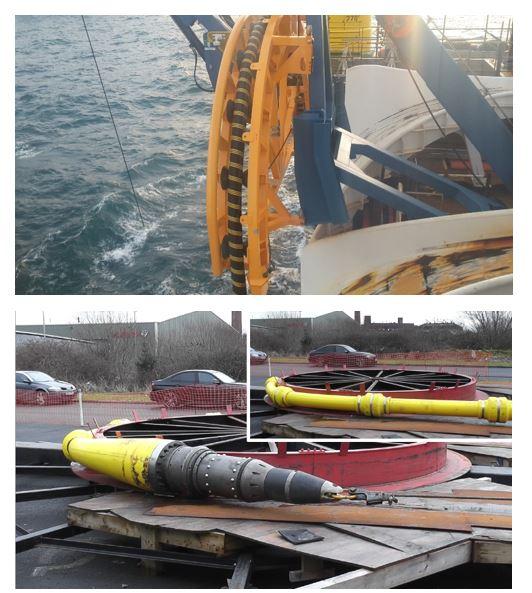
- Subsea Cable Protection Systems Installed On Offshore Wind Farm | Part 1 of 5
- Subsea Cable Protection & Laying Costs | Part 2 of 5
- Subsea Cable Protection Systems – Disconnection & Removal | Part 3 of 5
- Subsea Cable Protection Systems, Damage Prevention & Fixed WTG | Part 4 of 5
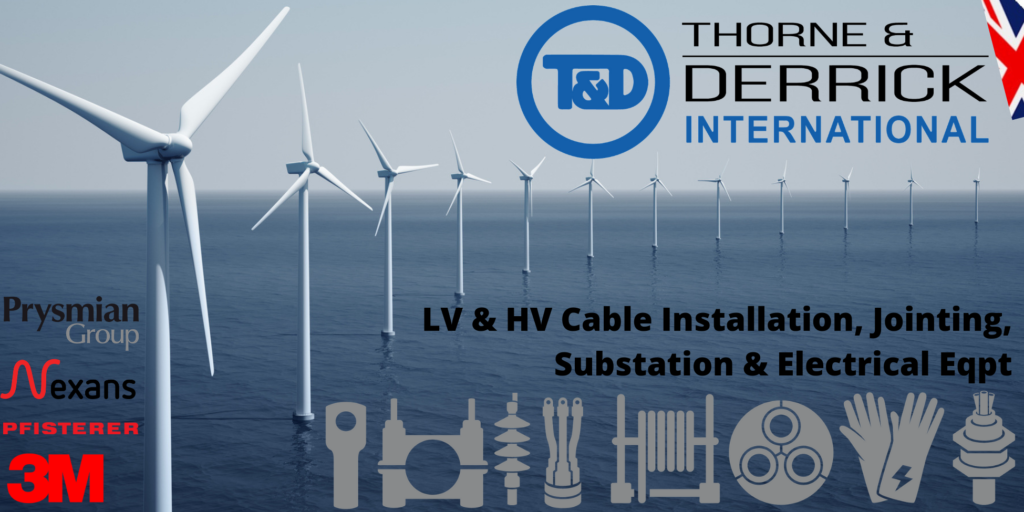
LV, MV & HV CABLE JOINTING, EARTHING, SUBSTATION & ELECTRICAL EQPT
Thorne & Derrick are Specialist Distributors to the UK and international Offshore Wind & Renewable industry to provide safe and reliable LV HV Electrical Cable & Power Distribution Systems – we are highly customer responsive and absolutely committed to providing a world-class service.
We have an International Distribution Agreement with Nexans Power Accessories UK to supply their Heat Shrink and Cold Applied ranges of 11kV/33kV/66kV joints and terminations and Euromold brand of separable connectors.
Since 1985, we have established an international reputation based on Service, Integrity and Trust – contact us.
t: 0191 410 4292 | e: [email protected] | www.powerandcables.com
We provide expert technical support and supply from a multi-million pound stock holding:
- Cable Joints, Terminations & Connectors Earthing & Lightning Protection
- Cable Accessories – Lugs, Glands
- Circuit Protection & Fuses
- Cable Cleats & Clamps Electrical Safety Equipment
- Cable Pulling & Laying Equipment
- Arc Flash Protection & Clothing
- Cable Duct Seals & Transit Systems Surge Arresters & Bushings
Further Reading:
- Arc Flash Clothing & Protection For Safe Windfarm & Wind Turbine Working
- Jointer Training Courses – 11kV 33kV 66kV MV HV Cable Jointer Competency Training
- Sealing Cables In Offshore Substations – A Roxtec CPD

Subsea Cable Protection Systems, Damage Prevention & Fixed WTG | Part 4 of 5
September 17th, 2019Subsea Cable Protection Systems
♦ Republished by Chris Dodds with Kind Permission of Greg Campbell-Smith ((Director Sales and Business Development at First Subsea)
First Subsea is the world’s leading developer of subsea connection technology, supplying, installing and decommissioning.
Subsea power cables on offshore wind farms are typically protected by means of burial.
This is a well proven means of cable protection used in other offshore industries.
However, at either end of offshore wind array cables they transition from burial, up through the water and into the wind turbine foundation. This free spanning section of cable is susceptible to what can be substantial wave and current loads.
These loads introduce movement and bending into the subsea cable which, without cable protection, can lead to over-bending, over-tensioning, fatigue and abrasion damage.
This exposed subsea cable is traditionally ‘protected’ by means of a relatively expensive and complex proprietary Cable Protection System (CPS).
Our 4th Article on Subsea Cable Protection Systems looks at why we need them for fixed wind turbine generators (WTG).
When First Subsea enteredthe renewable market we wanted to ask the simple question – Do we need subsea cable protection at all?
We had seen that traditional Cable Protection System (CPS) utilised bend restrictors which are designed to prevent overbending of subsea cables and from our studies we identified this would not occur in most projects. Restrictors also introduced additional loading to the subsea power cable due to hydrodynamic drag and increased inertia.
This in fact increased the risk of cable damage and reduced the inherent cable fatigue life.
This led us to reasoning why put a restrictor based CPS on at all if it reduces your cable life?
What Do You Think?
The study did identify that subsea medium/high voltage power cables cannot be left unprotected.
There is still a risk of cable damage due to Fatigue where the cable exits the foundation interface and Abrasion and Foreign body impacts.
These risks should be mitigated with a CPS optimised to protect against these types of damages. An optimised CPS design using stiffening elements like Bend Stiffeners and tubes will reduce the risk of subsea cable damage, including fatigue over the life of the wind farm.
➡ If you would like a copy of the report, please contact Chris Dodds [email protected]
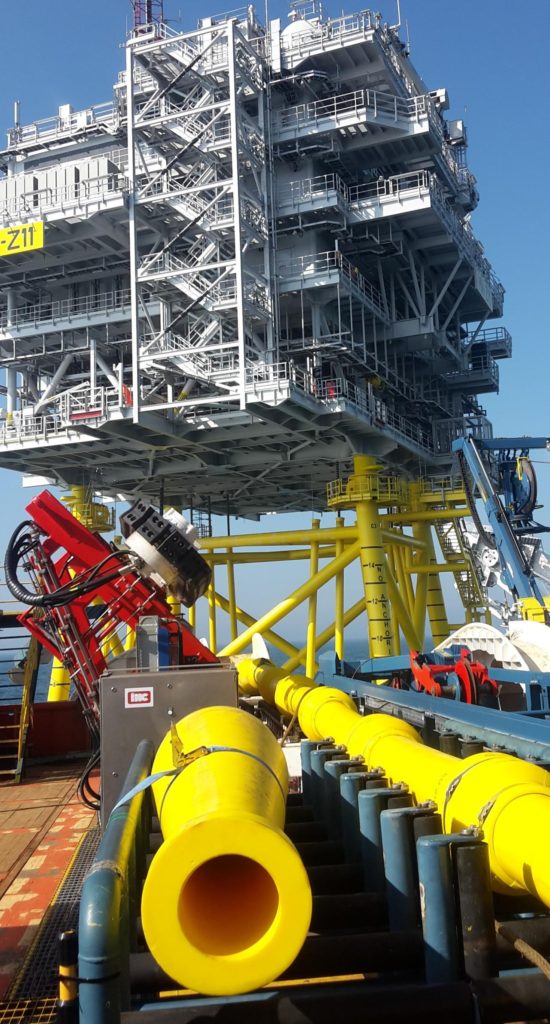
- Subsea Cable Protection Systems Installed On Offshore Wind Farm | Part 1 of 5
- Subsea Cable Protection & Laying Costs | Part 2 of 5
- Subsea Cable Protection Systems – Disconnection & Removal | Part 3 of 5
- Subsea Cable Protection Systems Design For Installation | Part 5 of 5

LV, MV & HV CABLE JOINTING, EARTHING, SUBSTATION & ELECTRICAL EQPT
Thorne & Derrick are Specialist Distributors to the UK and international Offshore Wind & Renewable industry to provide safe and reliable LV HV Electrical Cable & Power Distribution Systems – we are highly customer responsive and absolutely committed to providing a world-class service.
We have an International Distribution Agreement with Nexans Power Accessories UK to supply their Heat Shrink and Cold Applied ranges of 11kV/33kV/66kV joints and terminations and Euromold brand of separable connectors.
Since 1985, we have established an international reputation based on Service, Integrity and Trust – contact us.
t: 0191 410 4292 | e: [email protected] | www.powerandcables.com
We provide expert technical support and supply from a multi-million pound stock holding:
- Cable Joints, Terminations & Connectors Earthing & Lightning Protection
- Cable Accessories – Lugs, Glands
- Circuit Protection & Fuses
- Cable Cleats & Clamps Electrical Safety Equipment
- Cable Pulling & Laying Equipment
- Arc Flash Protection & Clothing
- Cable Duct Seals & Transit Systems Surge Arresters & Bushings
Further Reading:
- Arc Flash Clothing & Protection For Safe Windfarm & Wind Turbine Working
- Jointer Training Courses – 11kV 33kV 66kV MV HV Cable Jointer Competency Training
- Sealing Cables In Offshore Substations – A Roxtec CPD



